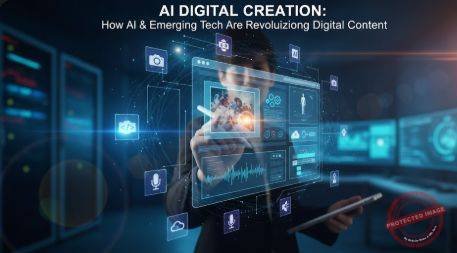From Algorithms to Artistry—How Artificial Intelligence, Cloud Platforms, and Real-Time Tools Are Empowering a New Generation of Digital Creators.
The Digital Renaissance of Creativity
The world of content creation is undergoing a revolution. Once confined to expensive studios and professional-grade hardware, creative expression is now accessible to anyone with a smartphone, laptop, or imagination. The democratization of creativity—powered by Artificial Intelligence (AI), cloud computing, and next-generation software tools—has given rise to what experts call the Creator’s Renaissance.
This transformation is blurring the line between technology and artistry. Machines no longer just process data—they collaborate in creativity, helping artists, designers, and producers transform concepts into professional-grade visuals, videos, and soundscapes at unprecedented speed.
AI: The New Creative Partner
Artificial Intelligence has evolved from a background tool into a co-creator. AI now plays a direct role in ideation, design, editing, and production, offering creative assistance that enhances human potential rather than replacing it.
Examples include:
-
Text-to-image generators like DALL·E 3 and Midjourney producing studio-quality visuals from written prompts.
-
AI video editors such as Runway ML and Pika Labs automating scene generation and transitions.
-
Music AI models like Suno AI and Udio composing personalized soundtracks in seconds.
-
Voice synthesis tools creating lifelike narrations and multilingual dubbing for global audiences.
This new synergy allows creators to focus on imagination while AI handles technical complexity—ushering in an era of intelligent creativity.
Democratization of Production
In the past, producing professional content required expensive hardware and specialized skills. Today, cloud-based creative platforms have removed those barriers entirely.
-
Adobe Firefly, Canva Magic Studio, and Descript integrate AI directly into workflows.
-
Browser-based editing tools allow creators to produce high-quality media from anywhere.
-
Generative templates simplify motion graphics, podcast editing, and marketing campaigns.
This democratization means anyone—from a student to a small business owner—can produce content that rivals enterprise-grade media. The creative economy has never been more inclusive, scalable, or globally connected.
The Rise of the Creator Economy
The merging of AI-powered creation and digital distribution has sparked a creator economy estimated at over $250 billion and growing rapidly. Platforms like YouTube, TikTok, and Twitch have evolved from entertainment channels to entrepreneurial ecosystems where individuals build personal brands, monetize content, and cultivate global communities.
With advanced analytics, automated editing, and real-time audience engagement, creators can now scale their reach and influence like never before. The next generation of creators are not just artists—they are digital entrepreneurs.
Real-Time Collaboration in the Cloud
Creative production has shifted from isolated workflows to real-time collaboration powered by cloud technology.
-
Frame.io, Notion, and Figma enable teams to co-edit visual assets from different continents.
-
Google’s Vertex AI and NVIDIA Omniverse allow 3D artists and video producers to collaborate on shared virtual environments.
-
Cloud rendering and distributed processing ensure projects complete faster, cheaper, and with fewer resource constraints.
The result: creativity that’s not bound by location, hardware, or time zones—only by imagination.
Generative Design and Automation
AI-driven generative design tools are revolutionizing how creators approach concept development. Algorithms can now analyze millions of design patterns, color palettes, and layouts to produce optimized creative options.
In marketing, AI automatically generates personalized video ads based on audience data. In gaming, procedural generation creates infinite environments dynamically.
Automation is no longer about efficiency alone—it’s about expanding creative horizons, enabling humans to design at a scale and speed previously unimaginable.
Challenges in the New Creative Landscape
While technology empowers creators, it also presents challenges:
-
Authenticity: Audiences are increasingly skeptical of AI-generated content.
-
Ethics: AI models trained on copyrighted material raise questions about ownership and originality.
-
Skill Gap: Creators must learn to work with AI rather than compete against it.
-
Information Overload: The surge of digital content risks saturating attention economies.
Balancing innovation with integrity is now the defining challenge of modern creativity.
Closing Thoughts and Looking Forward
We are witnessing a global redefinition of creativity—where code meets color, and algorithms amplify imagination. AI and digital platforms have turned creativity into an accessible, intelligent, and collaborative experience, inspiring millions to become creators rather than consumers.
As technology continues to evolve, the future of content creation will be defined not by machines that replace humans, but by humans who master machines to create something greater than either could alone.
Welcome to the Creator’s Renaissance—a movement where art and intelligence converge to shape the culture of tomorrow.
References
-
“AI in Creative Industries: The New Partnership Between Humans and Machines” – World Economic Forum
https://www.weforum.org/agenda/2024/08/ai-in-creative-industries -
“The Future of the Creator Economy” – McKinsey & Company
https://www.mckinsey.com/industries/technology/our-insights/the-future-of-the-creator-economy -
“Generative AI and the Next Era of Design” – Deloitte Insights
https://www.deloitte.com/insights/generative-ai-and-the-next-era-of-design -
“AI Tools for Audio, Video, and Image Creation” – MIT Technology Review
https://www.technologyreview.com/2024/10/02/ai-tools-for-audio-video-image-creation -
“The Democratization of Creativity in the Cloud” – Forbes Tech Council
https://www.forbes.com/sites/forbestechcouncil/2024/09/14/the-democratization-of-creativity-in-the-cloud
Author: Serge Boudreaux – AI Hardware Technologies, Montreal, Quebec
Co-Editor: Peter Jonathan Wilcheck – Miami, Florida
Post Disclaimer
The information provided in our posts or blogs are for educational and informative purposes only. We do not guarantee the accuracy, completeness or suitability of the information. We do not provide financial or investment advice. Readers should always seek professional advice before making any financial or investment decisions based on the information provided in our content. We will not be held responsible for any losses, damages or consequences that may arise from relying on the information provided in our content.



